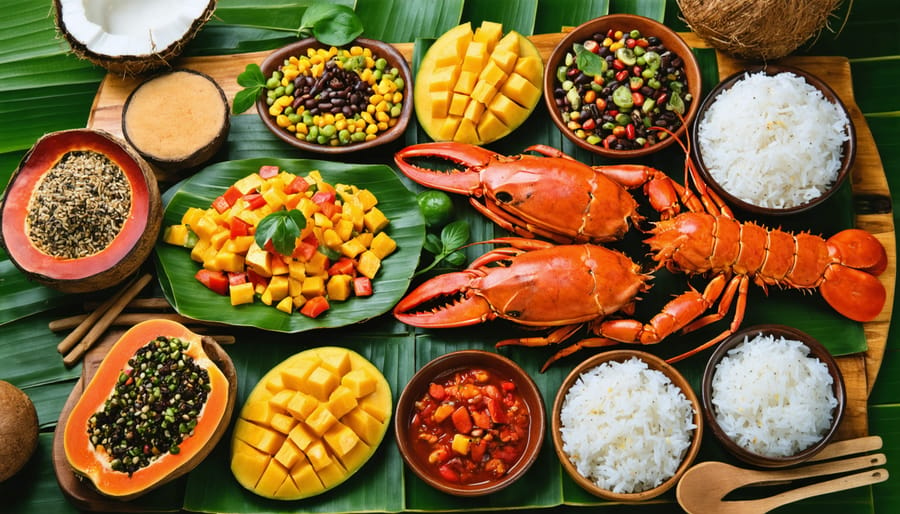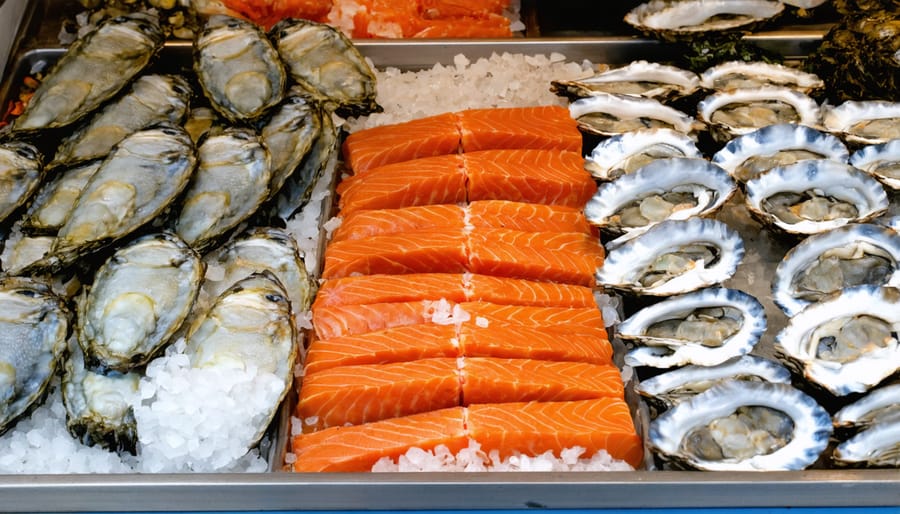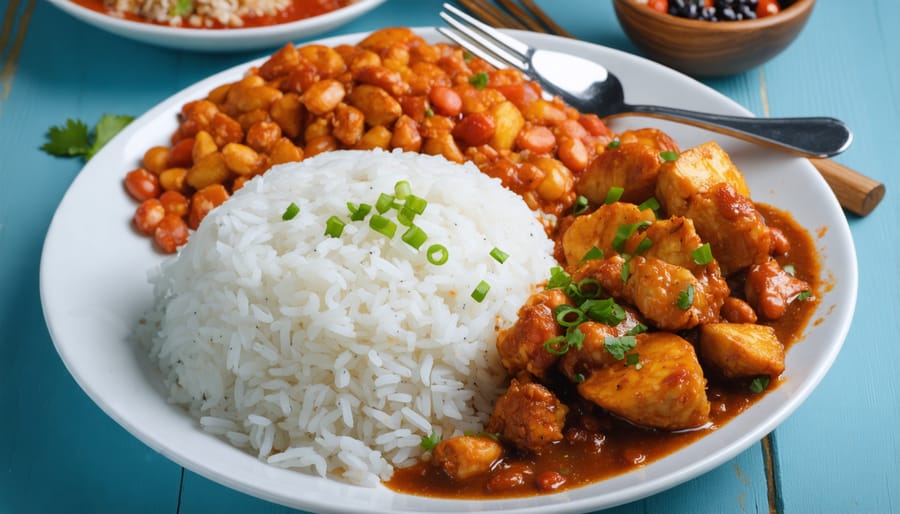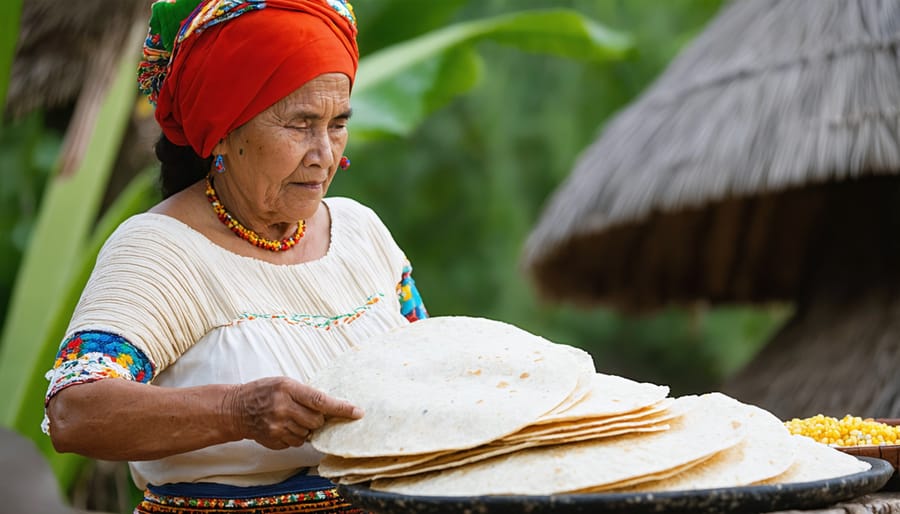
Dive into the vibrant world of Belizean cuisine, where centuries of Maya, Creole, Garifuna, and Caribbean influences merge to create a culinary tapestry as colorful as the country’s barrier reef. In my journey exploring cultural cuisines, I’ve discovered that Belize’s food story is more than just recipes—it’s a celebration of cultural resilience, family traditions, and the abundant gifts of both land and sea.
From the sizzling street corners of Belize City to the humble kitchens of inland villages, Belizean food captures the essence of this diverse nation. Here, you’ll find coconut-infused rice and beans simmering alongside spicy seafood dishes, while hand-pressed corn tortillas puff up over wood-fired comals. This is where African, Indigenous, and European cooking techniques blend seamlessly, creating dishes that tell the story of a nation shaped by multiple cultural migrations.
Whether you’re craving the comfort of a hearty bowl of boil-up, the zesty kick of ceviche, or the sweet satisfaction of traditional cassava pudding, Belizean cuisine offers a tantalizing glimpse into a culture where food is more than sustenance—it’s a daily celebration of heritage and community.
The Heart of Belizean Cooking: Essential Ingredients
From Sea to Table
Along Belize’s pristine coastline, the abundance of fresh seafood has shaped the country’s culinary identity for generations. From the moment local fishermen return with their daily catch to the vibrant preparations in coastal kitchens, seafood remains at the heart of Belizean cuisine. Traditional seafood preparation techniques have been passed down through families, creating dishes that celebrate the ocean’s bounty.
The star of Belizean seafood is undoubtedly the spiny lobster, often grilled to perfection and served with coconut rice. Fresh-caught snapper, grouper, and barracuda are transformed into hearty fish stews or the beloved pan-seared whole fish with crispy garlic. Conch, a local delicacy, appears in everything from fritters to ceviche, its sweet meat perfectly complemented by citrus and Caribbean spices.
What makes Belizean seafood truly special is the way coastal communities have maintained their traditional fishing practices while embracing sustainable methods. Whether you’re enjoying a bowl of rich coconut fish soup or savoring grilled shrimp on a beachfront, each bite tells a story of Belize’s deep connection to its waters.

Tropical Bounty
Step into any Belizean market, and you’ll be greeted by a vibrant array of tropical treasures that form the backbone of local cuisine. The air is filled with the sweet fragrance of ripe mangoes, papayas, and soursop, while piles of fresh coconuts await their transformation into rich, creamy dishes. I’ll never forget my first taste of sapodilla – its brown sugar sweetness was a revelation!
Local cooks rely heavily on fresh herbs and spices like culantro (similar to cilantro but more pungent), allspice, and the fiery habanero pepper. Root vegetables like cassava, sweet potatoes, and yellow yams are market staples, often becoming hearty side dishes or starring in traditional soups.
The abundance of plantains – both green and ripe – shows just how versatile this cousin of the banana can be, appearing in everything from savory sides to sweet desserts. Fresh annatto seeds add their distinctive red-orange color and earthy flavor to many traditional dishes, while locally grown recado (a spice paste) brings depth to marinades and stews.
These ingredients aren’t just food – they’re a testament to Belize’s fertile soil and the agricultural wisdom passed down through generations.
Iconic Belizean Dishes You Need to Try
Rice and Beans: The National Dish
When I first visited Belize, I quickly learned that rice and beans isn’t just another side dish – it’s the heart and soul of Belizean cuisine. This beloved combination appears on virtually every lunch and dinner table across the country, from humble home kitchens to bustling restaurants.
The dish consists of red kidney beans cooked with coconut milk, garlic, onions, and an array of local spices, served alongside perfectly fluffy white rice. What makes Belizean rice and beans truly special is the use of fresh coconut milk, which adds a subtle sweetness and creamy texture that’s distinctly Caribbean.
In many Belizean households, Sunday afternoon is dedicated to preparing a big pot of rice and beans. I’ve had the privilege of learning from local cooks who shared their secret: letting the beans simmer slowly until they’re velvety soft, then cooking the rice in the seasoned coconut milk until it absorbs all those wonderful flavors.
This dish represents more than just sustenance – it’s a symbol of Belize’s cultural heritage, blending influences from African, Maya, and Caribbean cuisines. Typically served with stewed chicken, plantains, or fresh seafood, rice and beans provides the perfect foundation for any Belizean meal. The beauty lies in its simplicity and the way it brings people together, making it a true taste of Belizean hospitality.

Street Food Favorites
Walking through the vibrant streets of Belize, you’ll discover a world of irresistible aromas and flavors that tell the story of this diverse nation. Street food here isn’t just quick sustenance – it’s a cherished part of daily life where cultures merge and memories are made.
One of the most beloved street snacks is the corn tortilla-based garnache, topped with refried beans, cheese, and tangy cabbage slaw. You’ll find locals gathering around food carts in the evening, sharing stories while enjoying these crispy delights. Another crowd favorite is the salbute, a puffy fried tortilla topped with shredded chicken, tomatoes, and avocado – perfect for a quick lunch or late-night craving.
Don’t miss the meat pies, Belize’s answer to the empanada, filled with seasoned chicken or beef in a flaky pastry shell. These handheld treats are particularly popular during morning commutes, when you’ll see office workers and students alike enjoying them with hot coffee.
For something sweet, look for street vendors selling tableta, a coconut candy that perfectly captures the tropical essence of Belize. And during summer months, nothing beats a frozen cocolmeca, a traditional coconut and milk popsicle that helps beat the heat while celebrating local flavors.
The beauty of Belizean street food lies in its accessibility and the way it brings people together, creating impromptu community gatherings around favorite food stalls and carts.
Festival Foods and Special Occasions
Belizean festivals and special occasions are marked by an array of mouthwatering dishes that bring families and communities together. During Christmas, the aroma of freshly baked rum cake and black fruit cake fills homes across the country, while traditional white relleno – a hearty soup made with whole chicken stuffed with pork, raisins, and olives – takes center stage at the dinner table.
Easter celebrations wouldn’t be complete without the beloved cross buns, spiced with cinnamon and nutmeg, often shared among neighbors as a symbol of community spirit. For the September Celebrations, marking Belize’s independence, streets come alive with the sizzling sounds of barbecued meats and the sweet scent of rice and beans cooked over open fires.
During the San Pedro Lobsterfest, held each June, locals and visitors alike feast on creative lobster dishes, from grilled tails with garlic butter to innovative lobster tacos. Maya communities celebrate the Day of the Dead with traditional dishes like pibil (underground-cooked meat) and hand-pressed corn tortillas.
The November 19th Garifuna Settlement Day brings the distinctive flavors of hudut (fish cooked in coconut broth served with mashed plantains) and darasa (banana tamales) to the forefront, celebrating the rich heritage of the Garifuna people. These festive dishes not only satisfy hunger but also help preserve and share Belize’s diverse cultural traditions.
Cultural Influences on Belizean Cuisine
Maya Heritage
When you explore Belizean cuisine today, you’re tasting history that stretches back to the ancient Maya civilization. The Maya people, who once built magnificent cities throughout Belize, laid the foundation for many cooking techniques and ingredients that remain essential in modern Belizean kitchens.
Take corn, for instance – it’s not just any ingredient but a sacred staple that the Maya people transformed into the versatile masa (corn dough) we still use today. When you bite into a warm, handmade corn tortilla in Belize, you’re experiencing a tradition that’s thousands of years old. The Maya also gifted us the technique of cooking meat in underground pits, known as pibil, which influences how many Belizeans prepare special occasion dishes today.
Many of the herbs and spices that give Belizean food its distinctive flavor profile – like achiote (annatto), allspice, and vanilla – were first cultivated and used by the Maya. They taught us how to process cacao into chocolate, a tradition that lives on in local Maya communities where women still hand-grind cacao beans using traditional stone tools.
In my visits to Maya villages in southern Belize, I’ve watched families prepare traditional dishes like cal-do (a hearty turkey soup) and corn-based drinks like atole, keeping these ancient culinary traditions alive. These recipes haven’t just survived; they’ve evolved, blending seamlessly with other cultural influences to create the vibrant tapestry of modern Belizean cuisine.

Caribbean and Creole Fusion
The vibrant flavors of Belize’s cuisine owe much to its rich Caribbean and Creole heritage, creating a delicious tapestry of tastes that tells the story of generations of cultural exchange. I remember my first visit to a local family’s home in Dangriga, where the grandmother showed me how to properly season coconut rice with fresh coconut milk and aromatic spices – a cooking technique passed down through generations of Garifuna families.
Caribbean influences shine through in the abundant use of seafood, coconut, and tropical fruits. You’ll find these elements masterfully combined in dishes like curry coconut fish and traditional rice and beans cooked in coconut milk. The Creole influence, brought by settlers from the Caribbean islands, adds depth with its signature blend of spices and cooking methods, particularly evident in popular dishes like stew chicken and cow foot soup.
What makes Belizean fusion cuisine special is how seamlessly these influences blend with local ingredients. Take the beloved boil-up, for example – a quintessential Creole dish that combines fish, root vegetables, and dumplings in a rich broth seasoned with Caribbean spices. Or the coconut fish stew, where fresh-caught snapper meets creamy coconut milk and Caribbean seasonings.
Even in modern Belizean kitchens, these cultural influences remain strong, with families adding their own contemporary twists while maintaining the soul of traditional recipes. It’s this beautiful marriage of Caribbean and Creole elements that gives Belizean cuisine its unique and unforgettable character.
Modern Belizean Kitchen
Contemporary Interpretations
Today’s innovative Belizean chefs are breathing new life into traditional recipes while honoring their cultural roots. In bustling restaurants from San Pedro to Belize City, you’ll find creative twists on beloved classics that speak to both tradition and modern tastes.
Take the iconic rice and beans, for instance. Forward-thinking chefs are now serving it with coconut-crusted fish or adding locally-sourced seasonal vegetables for added nutrition and color. Some are even experimenting with quinoa variations to cater to health-conscious diners while maintaining those cherished Belizean flavors.
Traditional tamales are getting makeovers too. I recently visited a charming café in Placencia where the chef creates fusion versions filled with lobster and local habanero peppers – a delightful marriage of Mayan tradition and coastal abundance.
Street food favorites aren’t left behind in this culinary evolution. Food trucks and modern eateries are serving gourmet versions of garnaches and panades, using artisanal tortillas and incorporating international ingredients while keeping the soul of these beloved snacks intact.
What’s particularly exciting is how young Belizean chefs are incorporating sustainable practices, working closely with local farmers and fishermen to source ingredients. This farm-to-table approach not only supports local communities but also ensures the authenticity of flavors while meeting contemporary dining expectations.
Preserving Tradition
In Belize, the heart of cultural preservation beats strongest in family kitchens, where recipes and cooking techniques are passed down like precious heirlooms. Grandmothers teach their daughters and granddaughters the art of hand-pressing corn tortillas, while sons learn the precise timing needed to perfect their father’s rice and beans recipe. These mindful cooking practices create bonds that stretch across generations.
Community gatherings and local festivals play a crucial role in keeping Belizean food traditions alive. During events like the Hopkins Mango Festival or the San Pedro Lobsterfest, families come together to showcase their culinary heritage, sharing not just meals but stories and techniques that have been cherished for centuries.
Many Belizean families maintain small kitchen gardens, growing traditional ingredients like recado, habanero peppers, and culantro (samat). This practice ensures that authentic flavors remain accessible while connecting younger generations to their agricultural roots. Local cooking classes and community programs have also emerged, where experienced cooks share their knowledge with enthusiasm.
Social media and food blogs have become unexpected allies in preservation efforts, with Belizean food enthusiasts documenting traditional recipes and techniques for future generations. These modern platforms help diaspora communities stay connected to their culinary roots while introducing authentic Belizean cuisine to a global audience.
Belizean cuisine is more than just a collection of recipes – it’s a vibrant tapestry of stories, traditions, and cultural pride passed down through generations. As modern life races forward, preserving these culinary traditions becomes increasingly important. Every time we prepare rice and beans with stewed chicken or share a plate of garnaches with friends, we’re not just enjoying a meal – we’re keeping our heritage alive. I’ve witnessed firsthand how food brings Belizean families together, creating bonds that stretch across dinner tables and generations. Whether you’re a native Belizean or a curious food lover, embracing these authentic flavors helps ensure that future generations will continue to taste, share, and celebrate the unique flavors that make Belizean cuisine so special. Let’s all do our part in keeping these delicious traditions alive, one home-cooked meal at a time.



